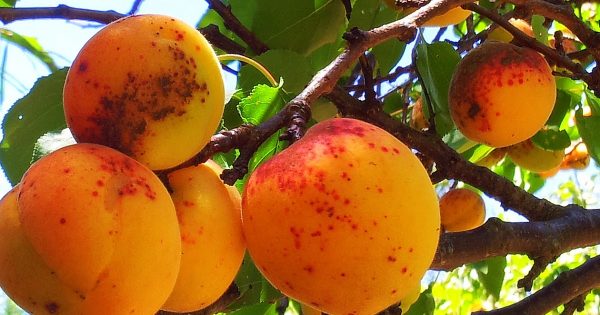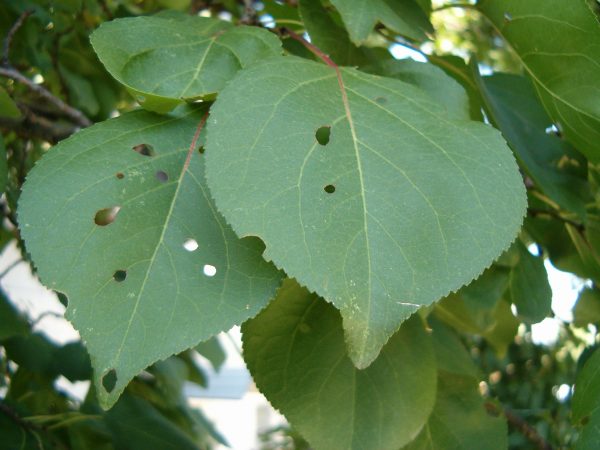Unfortunately, very often you can see brown or reddish spots on apricots. Many gardeners are interested in why brown spots appear on apricot fruits and what needs to be done to ensure that the fruits grow clean. The most suspicious and cautious people even doubt whether it is even possible to eat such spotted apricots.
The answer to the second question is simple - yes, of course you can eat such apricots.Although it is a disease, plant disease does not pose a danger to humans. Why do these dots appear on apricots and what should be done in such cases? Let's figure it out.
The spots on the fruit are initially small, reddish or brown in color, merge, grow and form warts (scaly elevations). Some of the scales in the spots fall off, forming depressions. With the strong development of this disease, which inexperienced gardeners mistake for scale insects, apricot fruits may lose both their presentation and taste.
This is an infectious fungal disease, clasterosporiasis.
The causative agent of the disease is a fungus that affects all plant organs. First, rounded small reddish spots form on the leaves. They then turn light brown in the middle of the leaf and have a crimson edge. In these places, the spots fall out and holes form (another name for the disease is perforated spotting).
With severe development of the disease, the leaves fall off. The pathogen penetrates into the shoots through the bud scales. The bark of the shoots cracks, and gum (sticky, resinous, frozen liquid) flows out of the resulting ulcers.
The development of fungal infection is promoted by elevated air temperatures (25 degrees and above).
But plants become infected in the spring, at a temperature of 5-6 degrees. The infection also develops during the tree’s dormant period—autumn and winter. At this time, the buds and shoots are affected.
How to deal with clusterosporiosis on apricots
- Cut out and destroy withered branches, twice: immediately after flowering and again after a month and a half. For the first time, the bulk of the affected branches are removed. For the second time, branches that dried out in June-August are cut out. This double summer cutting gives good results, because...Together with the drying branches, you remove the causative agent of clasterosporiosis from the garden.
- In the spring, before the buds open (on dormant buds), spray with a 1% solution of copper sulfate (100 g per 10 liters of water).
- During the growing season, the affected trees are sprayed with chorus: the first time - when the first signs of the disease appear, subsequent times at intervals of 7-10 days.
As you can see, the spots on apricot fruits are just the tip of the iceberg. With severe development of clusterosporiosis, the tree may even die.





 CUCUMBERS NEVER GET SICK, I'VE BEEN USING ONLY THIS FOR 40 YEARS! I SHARE A SECRET WITH YOU, CUCUMBERS ARE LIKE THE PICTURE!
CUCUMBERS NEVER GET SICK, I'VE BEEN USING ONLY THIS FOR 40 YEARS! I SHARE A SECRET WITH YOU, CUCUMBERS ARE LIKE THE PICTURE! You can dig a bucket of potatoes from each bush. Do you think these are fairy tales? Watch the video
You can dig a bucket of potatoes from each bush. Do you think these are fairy tales? Watch the video
 How our fellow gardeners work in Korea. There is a lot to learn and just fun to watch.
How our fellow gardeners work in Korea. There is a lot to learn and just fun to watch. Eye trainer. The author claims that with daily viewing, vision is restored. They don't charge money for views.
Eye trainer. The author claims that with daily viewing, vision is restored. They don't charge money for views. A 3-ingredient cake recipe in 30 minutes is better than Napoleon. Simple and very tasty.
A 3-ingredient cake recipe in 30 minutes is better than Napoleon. Simple and very tasty. Therapeutic exercises for cervical osteochondrosis.A complete set of exercises.
Therapeutic exercises for cervical osteochondrosis.A complete set of exercises. Which indoor plants match your zodiac sign?
Which indoor plants match your zodiac sign? What about them? Excursion to German dachas.
What about them? Excursion to German dachas.